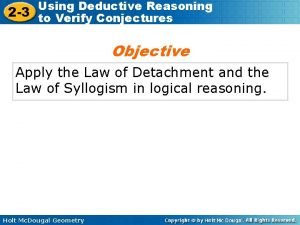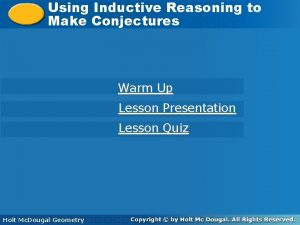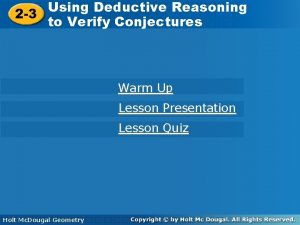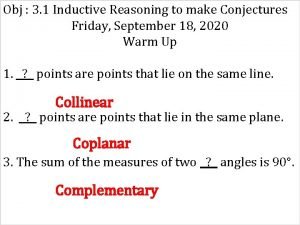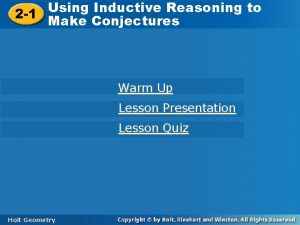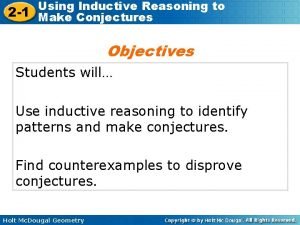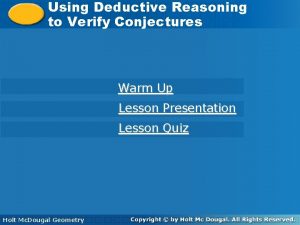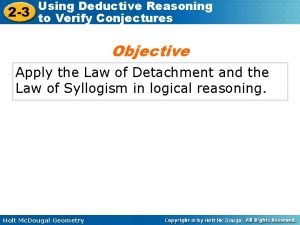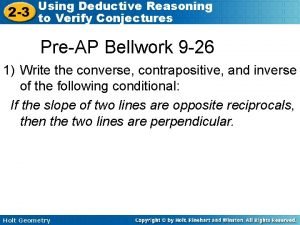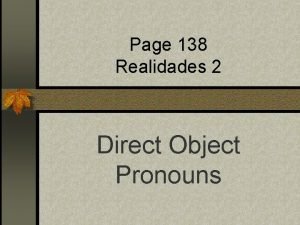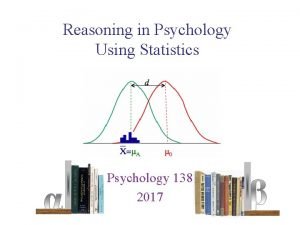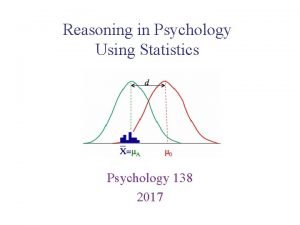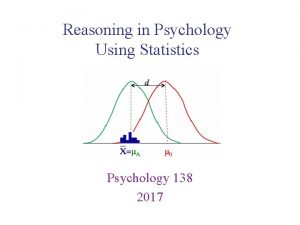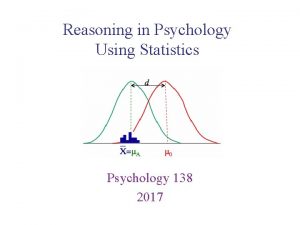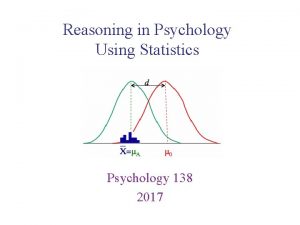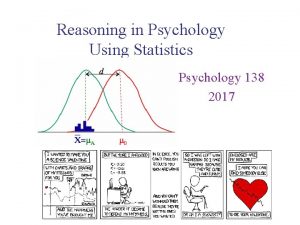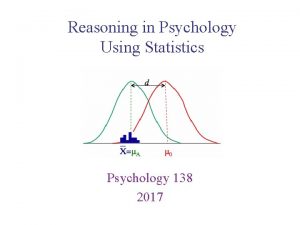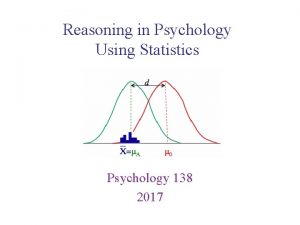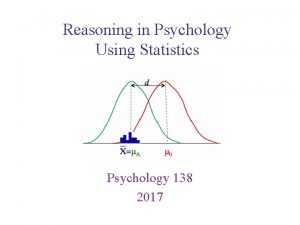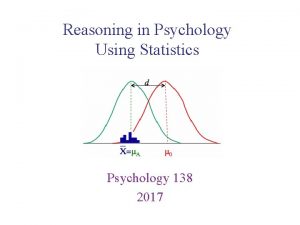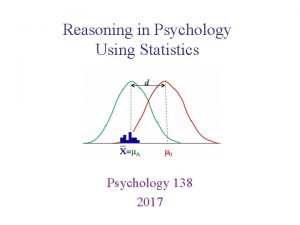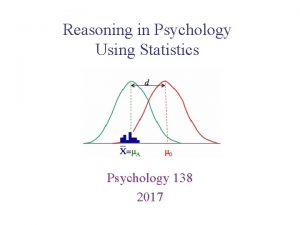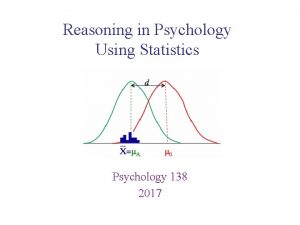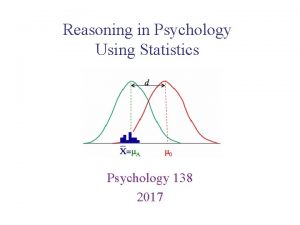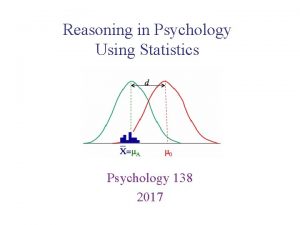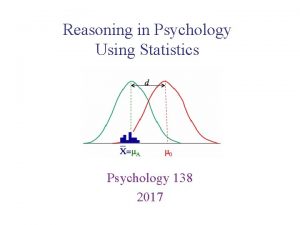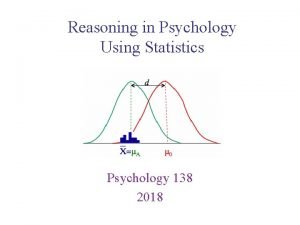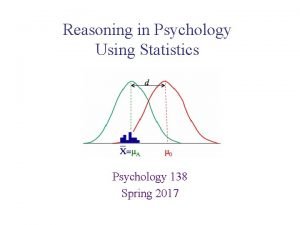Reasoning in Psychology Using Statistics Psychology 138 2017



















- Slides: 19

Reasoning in Psychology Using Statistics Psychology 138 2017

• Hypothesis testing • Estimation – Testing claims about populations (and the effect of variables) based on data collected from samples Sampling to make data collection manageable – Using sample statistics to estimate the population parameters Population Inferential statistics used to generalize back Sample Inferential statistics Reasoning in Psychology Using Statistics Cummings (2012) website

• Two kinds of estimates that use the same basic procedure Computing the point estimate or the confidence interval: • Step 1: Take your “reasonable” estimate for your test statistic • Step 2: Put it into the formula • Step 3: Solve for the unknown population parameter Center/point estimate? How do we find this? Depends on the design Use the t-table & your (what is being estimated) confidence level How do we find this? Depends on the design Estimation in other designs Reasoning in Psychology Using Statistics

Design Estimation (Estimated) Standard error One sample, σ known One sample, σ unknown Two related samples, σ unknown Two independent samples, σ unknown Things to note: • The design drives the formula used • The standard error differs depending on the design (kind of comparison) • Sample size plays a role in SE formula and in df’s of the critical value • Level of confidence comes in with the critical value used Estimation Summary Reasoning in Psychology Using Statistics

Confidence intervals always involve + a margin of error This is similar to a two-tailed test, so in the t-table, always use the “proportion in two tails” heading, and select the α-level corresponding to (1 - Confidence level) What is the tcrit needed for a 95% confidence interval? so two tails with 2. 5%+2. 5% = 5% or 95% in middle 2. 5% in each α = 0. 05, so look here 2. 5% 95% Estimates with t-scores Reasoning in Psychology Using Statistics

Estimating the difference between the population mean and the sample mean based when the population standard deviation is not known Confidence interval Diff. Expected by chance Estimation in one sample-t Reasoning in Psychology Using Statistics

Make an interval estimate with 95% confidence of the population mean given a sample with a X = 85, n = 25, and a sample s = 5. What two critical tscores do 95% of the data lie between? From the table: tcrit =+2. 064 So the confidence interval is: 82. 94 to 87. 06 or 85 ± 2. 064 2. 5% 95% Estimation in one sample t-design Reasoning in Psychology Using Statistics

Estimating the difference between two population means based on two related samples Confidence interval Diff. Expected by chance Estimation in related samples design Reasoning in Psychology Using Statistics

• Dr. S. Beach reported on the effectiveness of cognitive-behavioral therapy as a treatment for anorexia. He examined 12 patients, weighing each of them before and after the treatment. Estimate the average population weight gain for those undergoing the treatment with 90% confidence. Differences (post treatment - pre treatment weights): 10, 6, 3, 23, 18, 17, 0, 4, 21, 10, -2, 10 Related samples estimation Confidence level 90% CI(90%)= 5. 72 to 14. 28 Estimation in related samples design Reasoning in Psychology Using Statistics

Estimating the difference between two population means based on two independent samples Confidence interval Diff. Expected by chance Estimation in independent samples design Reasoning in Psychology Using Statistics

• Dr. Mnemonic develops a new treatment for patients with a memory disorder. He randomly assigns 8 patients to one of two samples. He then gives one sample (A) the new treatment but not the other (B) and then tests both groups with a memory test. Estimate the population difference between the two groups with 95% confidence. Independent samples t-test situation Confidence level 95% CI(95%)= -8. 73 to 19. 73 Estimation in independent samples design Reasoning in Psychology Using Statistics

• Notice that this interval includes zero • So the estimate of the population mean difference includes the possibility of zero (“no difference”) -8. 73 0 19. 73 • If we had instead done a hypothesis test with an α = 0. 05, what would you expect our conclusion to be? H 0: “there is no difference between the groups” - Fail to reject the H 0 CI(95%)= -8. 73 to 19. 73 Hypothesis testing with CIs Reasoning in Psychology Using Statistics

• Some argue that CIs are more informative than p-values Hypothesis testing & p-values Confidence Intervals • Gives plausible estimates of the pop • Dichotomous thinking – Yes/No reject H 0 (remember H 0 is “no effect”) Neyman-Pearson approach • Strength of evidence Fisher approach parameter (values outside are implausible) • Provide information about both level and variability • Wide intervals can indicate low power • Good for emphasizing comparisons across studies (e. g. , meta-analytic thinking) • Can also be used for Yes/No reject H 0 Estimation: Why? Reasoning in Psychology Using Statistics

• Two types typically – Standard Error (SE) • diff by chance – Confidence Intervals (CI) • A range of plausible estimates of the population mean CI: μ = (X) ± (tcrit) (diff by chance) Note: Make sure that you label your graphs, let the reader know what your error bars are Error bars Reasoning in Psychology Using Statistics

Important point! • In text (APA style) example • In graphs as error bars M = 30. 5 cm, 95% CI [18. 0, 42. 0] • In tables (see more examples in APA manual) Error Bars: Reporting CIs Reasoning in Psychology Using Statistics

• Practice computing and interpreting confidence intervals • Understanding CI: https: //www. youtube. com/watch? v=t. FWsu. O 9 f 74 o • Calculating CI: https: //www. youtube. com/watch? v=s 4 SRda. Tycaw • Kahn Academy: • CI and sample size: https: //www. youtube. com/watch? v=K 4 KDLWENXm 0 • CI and t-test: https: //www. youtube. com/watch? v=h. V 4 pdj. HCKu. A • CI for Ind Samp: https: //www. youtube. com/watch? v=hx. Z 6 uoo. EJOk (pt 2) • CI and margin of error: https: //www. youtube. com/watch? v=Uog. OJHg. JDqs • HT and CI: https: //www. youtube. com/watch? v=k 1 at 8 Vuk. Ibw • HT vs. CI rap: https: //www. youtube. com/watch? v=C 88 f. UKAHPn 0 • CIs by Geoff Cumming: • Introduction to: https: //www. youtube. com/watch? v=OK 6 DXf. Xv 8 BM • Workshop (6 part series) In labs Reasoning in Psychology Using Statistics

Group Differences: 95%CI Rule of Thumb • Error bars can be informative about group differences, but you have to know what to look for Rule of thumb for 95% CIs*: • If the overlap is about half of onesided error bar, the difference is significant at ~ p <. 05 • If the error bars just abut, the difference is significant at ~ p<. 01 *works if n > 10 and error bars don’t differ by more than a factor of 2 Cumming & Finch, 2005 Error Bars: Reporting CIs Reasoning in Psychology Using Statistics

• If we had instead done a hypothesis test on 2 independent samples with an α = 0. 05, what would you expect our conclusion to be? H 0: “there is no difference between the groups” MD = 2. 23, t(34) = 1. 25, p = 0. 22 MD = 2. 23, 95% CI [-1. 4, 5. 9] - Fail to reject the H 0 5. 9 -1. 4 0 Hypothesis testing with CIs Reasoning in Psychology Using Statistics

• If we had instead done a hypothesis test on 2 independent samples with an α = 0. 05, what would you expect our conclusion to be? H 0: “there is no difference between the groups” MD = 2. 23, t(34) = 1. 25, p = 0. 22 MD = 2. 23, 95% CI [-1. 4, 5. 9] -1. 4 MD = 3. 61, 95% CI [0. 6, 6. 6] - Fail to reject the H 0 5. 9 0 0. 6 - reject the H 0 MD = 3. 61, t(42) = 2. 43, p = 0. 02 Hypothesis testing with CIs Reasoning in Psychology Using Statistics 6. 6
 Definition of inductive method
Definition of inductive method Deductive reasoning process
Deductive reasoning process Deductive reasoning vs inductive reasoning
Deductive reasoning vs inductive reasoning Inductive and deductive reasoning geometry examples
Inductive and deductive reasoning geometry examples Every quiz has been easy therefore the quiz will be easy
Every quiz has been easy therefore the quiz will be easy Patterns and inductive reasoning
Patterns and inductive reasoning Strong argument example
Strong argument example Introduction to statistics what is statistics
Introduction to statistics what is statistics Deductive
Deductive Using inductive reasoning to make conjectures answers
Using inductive reasoning to make conjectures answers 2-3 using deductive reasoning to verify conjectures
2-3 using deductive reasoning to verify conjectures Using inductive reasoning to make conjectures
Using inductive reasoning to make conjectures 2-1 using inductive reasoning to make conjectures
2-1 using inductive reasoning to make conjectures Using inductive reasoning to make conjectures
Using inductive reasoning to make conjectures Using deductive reasoning to verify conjectures
Using deductive reasoning to verify conjectures Using deductive reasoning to verify conjectures
Using deductive reasoning to verify conjectures 2-3 using deductive reasoning to verify conjectures
2-3 using deductive reasoning to verify conjectures Salmo 138 5
Salmo 138 5 Direct object pronouns (p. 138)
Direct object pronouns (p. 138) Yeus138
Yeus138








